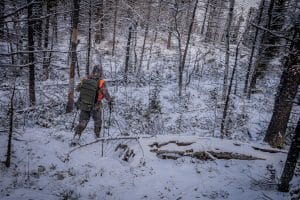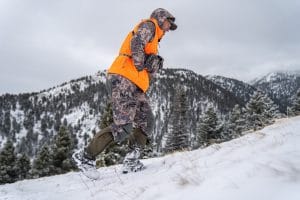Hunting in cold, wet, and nasty weather—where temperatures hover near or below freezing and rain or wet snow is constant—can be incredibly demanding and requires the proper wet weather clothing. Not only does it test your physical endurance, but it also pushes your clothing system to its limits. Whether you’re a fan of merino wool or synthetic materials, GORE-TEX or Windstopper, the principles of staying dry and warm remain the same. Here’s how to gear up for success in these challenging conditions.
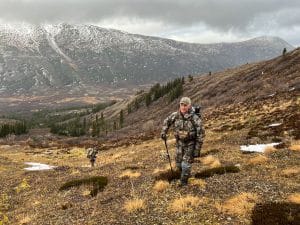
Wet Weather Clothing | The Right Layers
Synthetic Base Layers
When it comes to wet weather hunts, ditch the beloved merino wool and opt for synthetic base layers. Here’s why: during a 1,500-foot hike in the rain through dense brush, you’re going to sweat, and moisture will build up against your body. Synthetic fabrics excel at moving moisture away from your skin faster than any other material, keeping you drier and more comfortable.
Recommended synthetic base layers from Sitka,
Outer Jackets
A failsafe setup for places like the Yukon, where temperatures are low and rain can happen on the daily, includes a synthetic base layer, a durable outer jacket, and a pair of tough rain pants. For upper body, wear a synthetic base layer with a hood, topped with a windproof jacket that has a moisture-wicking liner. Sitka makes a great jacket that achieves this setup, consider looking into the Sitka Jetstream Jacket. This combination ensures that sweat is quickly transferred away from your body, even during intense activity.
Once you stop moving, it’s time to layer up. Consider carrying a synthetic puffy jacket for when you sit down to glass or take a break. This layer helps retain heat and prevents you from getting chilled. Hypothermia is a real risk in damp, cold conditions, especially between 30 and 40 degrees. Many cases occur because hunters underestimate the weather and don’t have the right gear to stay dry and warm when conditions take a turn for the worse. Sitka makes a couple of great puffy jackets, the Kelvin Hyperdown jacket and the Kelvin AeroLight jacket.
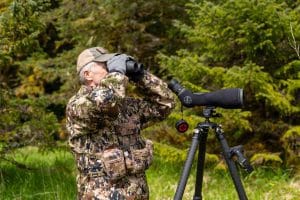
Layering for the legs
For legs, you can’t go wrong with a durable, water-resistant pants with zippers for ventilation. Over those pants, add a pair of soft shell pants, which can be lighter or heavier depending on the level of activity. The key is to have layers that are both durable and functional, especially when bushwhacking through rough terrain.
Here’s a couple pairs of pants that the Fresh Tracks Crew uses,
- Waterproof knees and seat make these pants perfect for nasty conditions
- When paired with a good base layer this pant can handle any season
- 100% waterproof, breathable Gore-Tex 3-layer laminate
- Sitka’s lightest rain pants
Don’t Forget Your Feet
Your boots are a critical part of your moisture and heat management system. The fresh tracks team prefers leather boots, specifically the Kenetrek Mountain Guide model, which we treat regularly to maintain their water resistance. A great product for boot treatment is Kenetrek’s waterproofing boot wax.
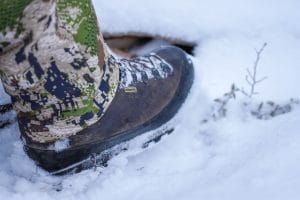
To add an extra layer of protection, wear gaiters over your boots. Gaiters prevent moisture from seeping into the cuffs of your pants and eventually into your socks and boots. This extra barrier is essential for keeping your feet dry during long, wet hunts. And if your feet do get wet, consider carrying an extra pair of socks.
Hands and Accessories
Your hands are another area that can suffer in cold, wet conditions. For temperatures in the 35-40 degree range, we recommend GORE-TEX gloves. These allow your hands to sweat slightly while hiking but move moisture out efficiently, keeping your hands dry and warm. It’s a simple yet effective solution for maintaining dexterity and comfort. For colder temps, consider carrying a pair mittens.
Here’s a few gloves that we use;
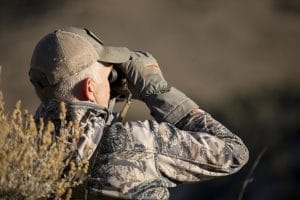
Keep It Simple
The beauty of this system is its simplicity. You don’t need a million different pieces of gear to stay comfortable in harsh conditions. By focusing on moisture-wicking synthetics, durable outer layers, and proper insulation, you can stay dry, warm, and ready for whatever the weather throws at you.
Hunting in terrible weather doesn’t have to be miserable. With the right gear and preparation, you can turn a challenging hunt into a rewarding adventure. The more prepared you are, the more fun you’ll have. So, gear up, stay dry, and embrace the elements. Good luck out there!
Some of the links in this article are affiliate links. If you purchase through them, we may earn a commission at no extra cost to you.



